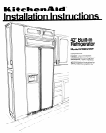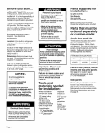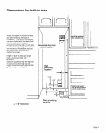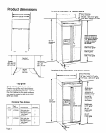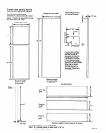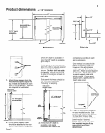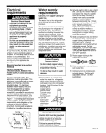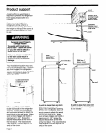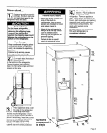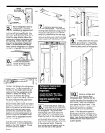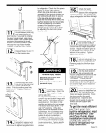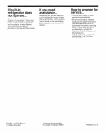
Electrical
requirements
Electrical Shock Hazard
l
Improper connection of the
equipment-grounding
conductor can result in a risk
of electrical shock. Check
with a qualified electrician or
service technician If you are
in doubt as to whether the
appliance is properly
grounded.
l
Do Not use an extension cord
with thls appliance. Such use
may result in a fire, electrical
shock, or other personal
injury.
A 120.volt, 60.Hz, AC only, 15or-20
ampere, fused, electrical supply is
required A time-delay fuse or circuit
breaker IS recommended. It is
recommended that a separate circuit
serving only this appliance be
providea
Recommended grounding
method
DO NOT, UNDER ANY
CIRCUMSTANCES, REMOVE THE
POWER SUPPLY CORD GROUNDING
PRONG.
For your personal safety, this
appliance must be grounded. This
appliance is equipped with a power
supply cord having a 3-prong
grounding plug. To minimize
possible shock hazard, the cord
must be plugged into
a
mating
3-prong, grounding-type wall
receptacle, grounded in accordance
with the National Electrical Code,
ANSVNFPA 70-latest edition, and
local codes and ordinances. See
Figure
1
If a mating wall receptacle
is not available, it is the personal
responsibility
and
obligation of the
customer to have a properly
grounded, 3-prong wall receptacle
installed by a qualified electrician.
3-prong
grounding type
wall receplacle
L
cord
Water supply
requiremkds
Use only l/4” copper tubing for
water line.
The water line to the refrigerator
must provide 15-100 psi water
pressure.
The preferred method of installing
the plumbing to the refrigerator is
through the wall. An optional
method is installing the water line
through a floor opening. If the
copper tubing is installed through
the floor, the hole cut in the floor
must be angled 45” toward the front.
You will need enough l/4”- copper
tubing to connect from water line to
refrigerator, a saddle-type valve and
a union. Rough in the water line
before installing the refrigerator. See
steps that follow.
Product/ Property
Damage Hazard
Do Not install copper tubing
in an area where temperatures
drop below freezing.
To do so may result in water
damage.
1
.Find a 3/8” to 1” vertical cold
water line near the refrigerator.
Measure the distance from the
cold water line to the refrigerator
location. Add 24 inches for the
final length of
copper tubing
you will need.
Cut both ends
of copper
tubing square.
2.Turn off
main water
supply and
clear water
line.
I
Electric Shock Hazard.
Electric drill must be grounded
to prevent severe or lethal
shock if water is in line and
enters drill during use.
Failure to ground drill may
result in personal injury.
3. Ground electric drill or use a hand
drill. Drill a 3/l 6” hole in vertical
cold water line. Attach a saddle
valve to the water line with a
clamp in an easily accessible
location. Insert a washer
between clamp and line. Check
that inlet end is solidly in the drill
hole. Tighten packing nut.
Tighten the pipe clamp screws
evenly so washer makes a
watertight connection. Do Not
overtighten or copper tubing
could be crushed.
4. Slide compression nut and sleeve
on copper tubing. Insert end of
copper tubing completely into
the outlet valve. Tighten
compression nut to outlet with an
adjustable wrench. Do Not
over-tighten. Turn on main water
supply and flush copper tubing.
Turn the new water line valve to
the “OFF” position.
5. Route copper tubing to the
refrigerator location.
6.
Slide compression nut and sleeve
over water line.
7.
Connect union to compression
nut and sleeve. Tighten with
adjustable wrench. Do Not
over-tighten.
Page 6



